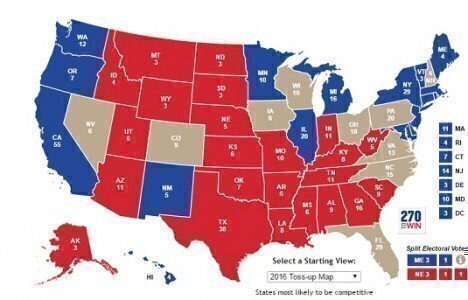For now, it looks like the battle lines are drawn for the 2016 presidential election, with Hillary Clinton and Donald Trump as the main combatants. But in this most unusual of races, are the traditional Swing States the same?

The answer is “maybe,” depending on whose definition of Swing States or Battleground States you are using.
Back in 2012 during the Barack Obama-Mitt Romney contest, there wasn’t an exact consensus on the number of Swing States or Battleground States that either candidate could win, where the polling was so close that each state’s outcome wasn’t known until all the votes were counted.
In May 2012, the list of possible Swing States ranged from nine to as many as 21 states. In 2008, there was a consensus that six Swing States were in play near the election’s end, while there were 11 states in play in 2004.
The presence of the Electoral College, an integral part of the Constitution, makes Swing States very important. A presidential candidate needs 270 electoral votes to win the election. For 48 states, it is a winner-take-all election within each state, with the winner getting every electoral vote. (Nebraska and Maine use a proportional vote system.)
So a state like New Hampshire, with its four electoral votes, was critical in a tightly projected race like the 2012 contest was expected to be. Nevada and Iowa were also important states in 2012, where President Obama gained enough small Swing State votes to lessen the importance of bigger swing states like Florida and Ohio.
With a clean slate in June 2016, the Democratic and Republican presidential candidates have already started targeting some battleground states. The website Politico tracks what it considers 11 Swing States, while another site, 270toWin.com, had 16 Swing States. RealClearPolitics, a site that tracks polling numbers, has 12 Battleground States.
In the end, polling numbers and demographics will determine what are the contested states in the fall contest. Here is a quick look at the possible battleground states, and how recent polls have treated the candidates in head-to-head match-ups.
Definite Swing States (11)
Colorado (Electoral Votes: 9)
Current Real Clear Politics Consensus Poll: No recent poll
Florida (Electoral Votes: 29)
Current Real Clear Politics Consensus Poll: Clinton +1.6
Iowa (Electoral Votes: 6)
Current Real Clear Politics Consensus Poll: No recent poll
Michigan (Electoral Votes: 16)
Current Real Clear Politics Consensus Poll: Clinton +8.3
Minnesota (Electoral Votes: 10)
Current Real Clear Politics Consensus Poll: No recent poll
Nevada (Electoral Votes: 16)
Current Real Clear Politics Consensus Poll: No recent poll
New Hampshire (Electoral Votes: 4)
Current Real Clear Politics Consensus Poll: Clinton +6.5
North Carolina (Electoral Votes: 15)
Current Real Clear Politics Consensus Poll: Trump +1
Ohio (Electoral Votes: 18)
Current Real Clear Politics Consensus Poll: Clinton +1.4
Pennsylvania (Electoral Votes: 20)
Current Real Clear Politics Consensus Poll: Clinton +4.0
Virginia (Electoral Votes: 13)
Current Real Clear Politics Consensus Poll: Clinton +4.3
Potential Swing States (5)
Arizona (Electoral Votes: 11)
Current Real Clear Politics Consensus Poll: Clinton +1.0
Georgia (Electoral Votes: 16)
Current Real Clear Politics Consensus Poll: Trump +4.2
New Mexico (Electoral Votes: 5)
Current Real Clear Politics Consensus Poll: Clinton +8
Oregon (Electoral Votes: 7)
Current Real Clear Politics Consensus Poll: Clinton +4.5
Wisconsin (Electoral Votes: 10)
Current Real Clear Politics Consensus Poll: Clinton +11.6
Recent Stories on Constitution Daily
The Miranda warning is born 50 years ago todayIt was 150 years ago today: Congress approved the 14th AmendmentPodcast: Hamilton, the man and the musical





